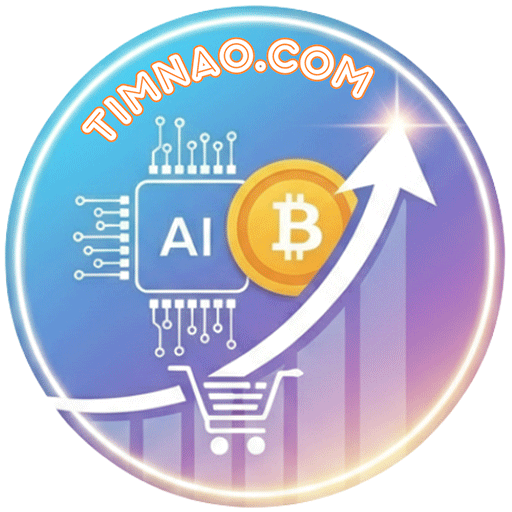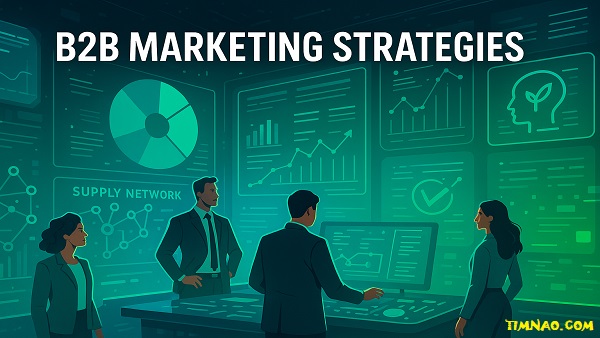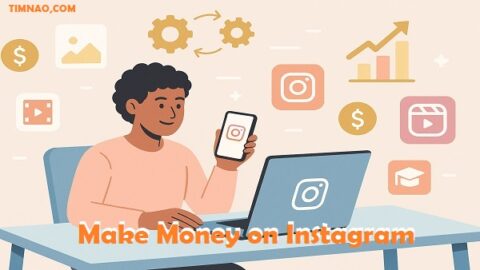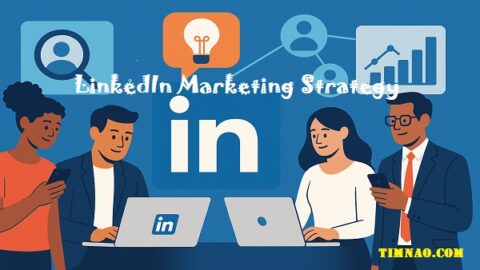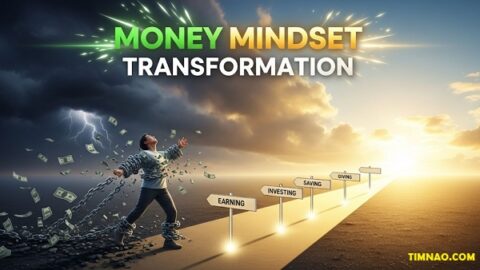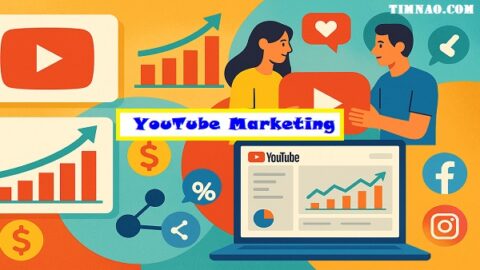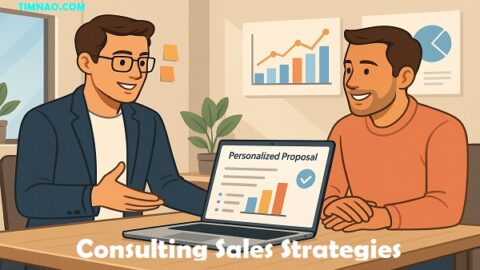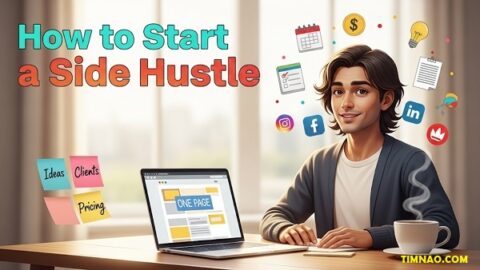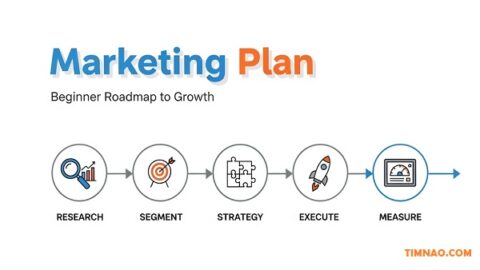Unstoppable B2B Growth: Proven Strategies to Outpace the Competition 🚀
B2B marketing strategies are no longer what they used to be. In 2025’s fast-paced digital world, it’s not enough to simply offer a good product or service—you need to build trust, deliver value, and create lasting relationships in an increasingly competitive landscape. Whether you’re a small business owner, a startup founder, or just beginning your journey in business-to-business marketing, knowing how to stand out is critical.
But with so many tactics, tools, and buzzwords out there—where do you even begin?
This beginner-friendly guide breaks down everything you need to know into simple, actionable insights. From mastering the modern marketing mix to understanding AI’s real role (beyond the hype), you’ll discover how to attract, convert, and retain high-value business clients without feeling overwhelmed.
Let’s explore the essential pillars of modern B2B success—smart strategies, human-centered leadership, ethical practices, and future-proof technology.
📚 Table of Contents
- 💼 What Is B2B Marketing and Why It’s Changing Fast
- 🧠 Key Theories Behind Modern B2B Marketing
- 🛠️ Crafting a Smart Marketing Mix for B2B Success
- 🎯 Top B2B Marketing Strategies That Work Today
- 🌱 Why Ethics and Sustainability Matter More Than Ever
- 🏆 Building Competitive Advantage in a Crowded Market
- 🧩 The Rise of Servitization and What It Means for You
- 🤖 Leveraging Technology in Digital B2B Marketing
- 👥 Leadership and People: The Hidden Power in B2B
- 🔗 Smarter Supply Networks for Modern Businesses
- 🧠 The Role of AI in B2B Marketing: More Than a Buzzword
- ✅ Final Thoughts and Actionable Takeaways
💼 What Is B2B Marketing and Why It’s Changing Fast
B2B marketing, or business-to-business marketing, refers to strategies that businesses use to sell products or services to other businesses—unlike B2C (business-to-consumer), which targets individuals. While it may sound straightforward, B2B marketing is undergoing a dramatic transformation driven by technology, customer expectations, and global dynamics.
🔄 From Transactions to Relationships
Historically, B2B was focused on bulk transactions—just supply and demand. But now, successful B2B marketing is about relationships, trust, and value creation. Today’s B2B buyers expect personalized service, digital engagement, and ethical business practices—just like consumers.
For example, companies like Salesforce and HubSpot don’t just sell software; they deliver ecosystems of support, education, and community—building long-term loyalty.
🌍 Why the B2B World Is Changing
Three major forces are reshaping B2B marketing:
- Digital Transformation – Buyers now research online before ever contacting a vendor. If your brand doesn’t have a digital presence, you’re invisible.
- Ethical Demands – Businesses want partners that care about sustainability, diversity, and responsible practices.
- Service Dominance – Even manufacturers are turning products into “services.” Think about how Xerox now sells managed print services rather than just printers.
🔑 B2B Is the Engine Behind the Economy
Even though it’s less visible than flashy consumer brands, B2B is everywhere. Logistics firms, raw material suppliers, software platforms, and data providers all operate in the B2B ecosystem. Without B2B transactions, B2C businesses couldn’t function.
Take Amazon Web Services (AWS), for example—it powers millions of businesses, from Netflix to Airbnb. That’s B2B in action.
🧠 Key Theories Behind Modern B2B Marketing
Understanding a few core theories can help you make smarter B2B decisions—especially if you’re new to the game.
1. Behavioral Theory
B2B buyers aren’t robots. Decisions are made by people influenced by company goals—but also by personal values, emotions, and experiences. Behavioral theory helps explain how trust, power, and long-term thinking affect buying choices.
💡 Tip for Beginners: Understand the people behind the purchase. Build relationships, not just proposals.
2. Social Exchange Theory
This theory emphasizes mutual benefit. In B2B, long-term relationships thrive on reciprocity, trust, and shared value—not just price. When both sides feel valued, loyalty follows.
✅ Real-World Example: Strategic alliances like Intel and Lenovo flourish because both invest in each other’s success.
3. Network Theory
B2B businesses don’t operate in silos. They’re part of interconnected networks—suppliers, customers, distributors, and partners. Success depends on nurturing these relationships across the board.
🔄 Key Insight: A strong network is a competitive asset. Map your ecosystem and identify who supports your value chain.
4. Supply Chain Theory
In the B2B world, the supply chain is everything. Timely production, cost control, and innovation often depend on how well you collaborate with your suppliers. This theory focuses on optimizing those connections.
🚚 Example: Apple’s ability to launch products seamlessly relies on tight, tech-driven supplier integration.
5. Diffusion of Innovation
When new products or ideas enter the market, not all businesses adopt them at the same time. This theory helps explain how innovation spreads and who the early adopters are.
📈 Strategy Tip: Tailor your pitch to your target’s adoption stage. Innovators want cutting-edge tech. Late adopters want proven results.
6. Service Dominant Logic
Forget selling just a “thing.” You’re selling value and outcomes. This logic shifts focus from products to solutions—and positions your customer as a co-creator of value.
💼 Modern Example: Instead of selling machines, Caterpillar offers performance-based contracts. Clients pay for machine uptime, not ownership.
7. Resource-Based View (RBV)
Your firm’s internal resources—like brand, culture, talent, or tech—can be a unique advantage. The RBV theory says sustainable competitive edge comes from using these in-house strengths wisely.
🛠️ Actionable Insight: Identify what makes your company special internally, and make that central to your B2B pitch.
🛠️ Crafting a Smart Marketing Mix for B2B Success
The B2B marketing mix is more than just product and price. It’s a strategic blend of factors that help businesses deliver the right value to the right clients—especially in complex, long-term relationships.
🔹 Understanding the 7Ps in a B2B Context
Most marketers know the classic 4Ps: Product, Price, Place, and Promotion. But in B2B marketing, we go further with three more: People, Process, and Physical Evidence. Let’s break them down:
| P | B2B Meaning |
|---|---|
| Product | Focus on how the product or service solves a specific business problem. Often customized. |
| Price | In B2B, pricing involves negotiations, long-term contracts, and value-based pricing. |
| Place | Distribution is often direct, sometimes through partners or platforms. |
| Promotion | Emphasize case studies, whitepapers, and industry events over emotional ads. |
| People | Your sales team and support staff are crucial to relationship-building. |
| Process | Buyers want smooth onboarding, easy procurement, and responsive service. |
| Physical Evidence | Think testimonials, certifications, client logos, and online demos. |
💡 Pro Tip: Make your value clear at every stage—from first impression to after-sales support.
🔸 From 4Ps to 4Cs: Customer-First Approach
To make the mix more customer-centric, shift your thinking from “what we offer” to “what they want.”
| 4Ps | → | 4Cs |
|---|---|---|
| Product | → | Customer solution |
| Price | → | Customer cost |
| Place | → | Convenience |
| Promotion | → | Communication |
🔄 For example, instead of just promoting a cloud software’s features, show how it reduces operational costs or simplifies compliance.
⚙️ Digital Impact on the Marketing Mix
Modern B2B marketing is deeply digital. Think CRM tools, email workflows, retargeting ads, webinars, AI chatbots, and SEO.
📊 Real-World Insight: 94% of B2B buyers now do research online before purchasing. Your website, LinkedIn profile, and customer reviews are often your first touchpoints—make them count.
🎯 Top B2B Marketing Strategies That Work Today
A great strategy turns theory into traction. Here are the most effective B2B marketing strategies for today’s digital-first, value-driven world—especially if you’re just getting started.
🔍 1. Account-Based Marketing (ABM)
ABM is about targeting specific high-value accounts with tailored messages and offers.
🎯 For example, if you sell cybersecurity software, you might build a unique pitch for a healthcare company’s IT team—based on their pain points, not a generic ad.
Tools to Try:
💡 Beginner Tip: Start small—target 5-10 key prospects and personalize outreach.
💬 2. Relationship Marketing
In B2B, trust takes time—so build relationships, not just leads. Stay top-of-mind with:
- Personalized email follow-ups
- Thoughtful LinkedIn engagement
- Exclusive access to resources
✅ Example: Instead of spamming contacts, create a VIP newsletter that shares niche industry insights relevant to their role.
🌱 3. Sustainability Marketing
Modern buyers care about values. Sustainability is no longer a “nice to have”—it’s a competitive edge.
📦 Case Example: A packaging supplier highlighting their zero-waste operations can win contracts from brands like Unilever or Nestlé that prioritize ESG compliance.
🟢 Action Tip: Make your green efforts visible in RFPs, pitch decks, and product pages.
💡 4. Innovation Marketing
Don’t just deliver value—create it. Innovation marketing means positioning your product or service as a forward-thinking solution.
⚡ Example: Instead of just selling software, position your SaaS as a way for businesses to future-proof operations with AI-driven features.
Ideas to apply:
- Run pilot programs
- Host innovation webinars
- Partner with startups
📲 5. Digital Marketing
B2B buyers expect a consumer-grade experience. That means fast websites, rich content, and data-driven targeting.
Key Channels That Convert:
- LinkedIn Ads (especially with lead gen forms)
- SEO blog content (like this article!)
- Email automation with tools like ActiveCampaign or Mailchimp
🧠 Smart Move: Map your buyer journey and create content for each stage—awareness, consideration, and decision.
🔄 6. Servitization Strategy
Servitization is about turning your product into a solution. Think: bundling a product with services like support, maintenance, or consultancy.
🚜 Example: Instead of selling tractors, John Deere sells “uptime” with remote diagnostics, training, and proactive service.
💼 This approach:
- Adds value to your offering
- Locks in long-term contracts
- Builds trust through ongoing engagement
🎯 Strategy Stack for Beginners
| Stage | Strategy |
|---|---|
| Awareness | Digital content (SEO, social, webinars) |
| Consideration | ABM, innovation demos, reviews |
| Decision | Relationship marketing, case studies, free trials |
Quick Tip: Don’t try everything at once. Master one channel, then layer on others.
🌱 Why Ethics and Sustainability Matter More Than Ever
In today’s hyper-connected and values-driven world, B2B buyers care about more than just cost and quality. They want to work with partners who share their ethical standards, sustainability goals, and long-term vision.
🧭 Ethics in B2B: More Than a Buzzword
Ethical marketing in B2B goes beyond “doing no harm.” It’s about transparency, trust, and fairness in every interaction—from sourcing to sales.
🔍 Real-world breakdown of ethical practices:
- Transparent pricing (no hidden fees or misleading terms)
- Data protection and cybersecurity
- Honest communication in pitches and proposals
- Responsible labor practices in supply chains
💡 Pro Tip: Ethics isn’t about perfection. It’s about consistently aligning your actions with your stated values.
🌍 The Sustainability Imperative
Sustainability has become a dealbreaker. Businesses increasingly prefer partners who demonstrate clear environmental and social responsibility.
According to recent reports:
🔹 83% of B2B buyers are more likely to engage with vendors who demonstrate sustainability leadership.
B2B firms can show this through:
- Green logistics and packaging
- Carbon-neutral operations
- Ethical sourcing and supplier audits
- Participation in global initiatives like the UN Sustainable Development Goals
♻️ The Triple Bottom Line: People, Planet, Profit
Forward-thinking businesses now use the Triple Bottom Line (TBL) framework, which balances:
- People – fair labor, diversity, community support
- Planet – environmental stewardship and emissions reduction
- Profit – financial sustainability for long-term growth
🏢 Case Study: Tech giant Cisco embedded sustainability into its entire supply chain—and saw both cost savings and new enterprise contracts as a result.
✅ Action Tips for Beginners
- Create an ethics & sustainability page on your website
- Show certifications or memberships (e.g., B Corp, ISO 14001)
- Train your team on ethical sales and compliance
- Integrate CSR stories into your marketing materials
- Ask your suppliers about their practices—your chain is only as strong as its weakest link
These steps don’t just check a box—they differentiate your brand and help build long-term trust with clients who care.
🏆 Building Competitive Advantage in a Crowded Market
Standing out in a B2B marketplace full of lookalike solutions requires more than a good product. You need a sustainable competitive advantage—one that clients can’t easily replicate.
Let’s explore a few key levers to help you rise above the noise.
💡 1. Co-Create Value With Clients
Rather than pushing a product, smart B2B brands co-create solutions with clients. This builds deep trust and drives better outcomes.
🧠 Example: Instead of selling analytics software as-is, offer onboarding sessions and data strategy workshops that help clients extract actual value.
💬 Quote to Remember:
“Value is not what you deliver—it’s what the customer experiences.”
🛣️ 2. Master the B2B Customer Journey
Every touchpoint—from awareness to after-sales support—should reinforce your brand’s value. Winning brands map their customer journey and optimize it step by step.
📌 Key Stages to Improve:
- Awareness (SEO, webinars, LinkedIn thought leadership)
- Consideration (case studies, personalized demos)
- Purchase (easy procurement process, clear SLAs)
- Loyalty (ongoing support, feedback loops)
💼 Smart Tip: Use tools like HubSpot or Zoho CRM to track and personalize interactions.
🌐 3. Embrace Digitalization for Scalability
Digital tools aren’t just for marketing—they’re key to scaling operations, improving accuracy, and increasing speed.
Top areas to digitize:
- Lead tracking and scoring
- Automated follow-ups
- Online proposal generation
- AI-powered chat and email support
🖥️ Example: Companies using automated workflows convert 50% more leads than those relying solely on manual outreach.
🧠 4. Leverage Thought Leadership
Become a source of insight, not just a product seller. Publish blog posts, appear on podcasts, and host niche webinars that educate your audience.
🎙️ Case Study: Cybersecurity firm Palo Alto Networks uses thought leadership to shape industry trends, positioning itself as a strategic advisor—not just a vendor.
📣 5. Build a Brand, Not Just a Business
People buy from businesses they know, like, and trust. In B2B, branding is often neglected—but it’s more important than ever.
🧱 Elements of strong B2B branding:
- Clear mission and messaging
- Consistent visual identity
- Reputation for integrity and results
🔗 Pro Tip: Make sure your brand shows up consistently across your LinkedIn page, proposals, emails, and website.
🛠️ Quick Advantage Checklist for Beginners
| Strategy | Why It Works |
|---|---|
| Value co-creation | Personalizes the offering |
| Digitalization | Increases efficiency and speed |
| Journey mapping | Enhances customer satisfaction |
| Thought leadership | Builds authority and trust |
| Branding | Differentiates in saturated markets |
Focus on one or two of these areas, and you’ll quickly gain traction—even if you’re a small B2B startup or freelancer.
🧩 The Rise of Servitization and What It Means for You
One of the most powerful (and often overlooked) shifts in modern B2B marketing is servitization—the transformation from selling standalone products to offering integrated product-service solutions.
It’s no longer enough to say, “Here’s our tool.” Today’s market asks:
👉 “How does this help me succeed—long after the sale?”
🧰 What Is Servitization?
Servitization is when manufacturers or product-based businesses bundle value-added services with their offerings to enhance the customer experience, build loyalty, and generate recurring revenue.
🎯 Example:
Instead of just selling air compressors, Atlas Copco offers “air-as-a-service.” Clients pay for uptime and output—not the machine itself.
🏗️ Why It’s Becoming Essential in B2B
The benefits of servitization go both ways:
| For Clients | For You (the Vendor) |
|---|---|
| Lower risk and upfront costs | Predictable recurring revenue |
| Access to support and expertise | Deeper customer relationships |
| Enhanced performance outcomes | Reduced churn and higher loyalty |
💡 SEO Tip: If you’re targeting phrases like B2B growth or business to business marketing, servitization aligns perfectly with client-centric value propositions.
🔄 Types of Servitization Models
You don’t need to overhaul your entire business model to get started. Here are three common entry points:
- Basic Services – Training, installation, maintenance
- Intermediate Services – Remote monitoring, upgrades, diagnostics
- Advanced Services – Outcome-based pricing, full performance contracts
🔧 Example: Rolls-Royce’s “Power by the Hour” sells engine performance, not engines—marking one of the most successful servitization models globally.
✅ Getting Started with Servitization
Here’s how to test servitization in your own B2B context:
- Talk to existing clients. Ask what pain points occur after purchase.
- Bundle services like onboarding, training, or custom reports.
- Shift from cost-based to value-based pricing.
- Use digital tools to deliver and track service performance (see next section).
Remember: even a small move toward a service-first mindset can give you a major edge in competitive markets.
🤖 Leveraging Technology in Digital B2B Marketing
Today’s B2B landscape runs on tech. From lead generation to long-term relationship management, the smartest marketers use automation, data, and AI to gain advantage.
If you’re new to digital tools, don’t worry. You don’t need to be a tech wizard. Start small, grow fast.
🧠 The Role of MarTech (Marketing Technology)
Marketing tech (MarTech) refers to the software and systems used to plan, execute, and analyze marketing campaigns.
Here’s a simple stack many B2B teams start with:
| Tool | Purpose |
|---|---|
| HubSpot or Zoho | CRM, email automation |
| Google Analytics | Website traffic and conversion tracking |
| SEMRush or Ahrefs | SEO research and optimization |
| LinkedIn Ads | B2B targeting and lead generation |
| Chatbots | Conversational lead qualification |
📈 Data Point: Companies that integrate CRM and marketing automation increase conversion rates by over 300%.
🧲 Using Tech to Attract and Convert B2B Buyers
1. SEO Optimization:
Start by identifying relevant keywords like B2B marketing strategies or digital B2B tools. Use them naturally in blog posts, FAQs, and landing pages.
2. Email Nurturing:
Set up automated email flows based on behavior. For example:
- A visitor downloads a whitepaper → Send them case studies and a free demo link over the next week.
3. Retargeting Campaigns:
Use tools like Google Ads or LinkedIn Retargeting to show ads to users who visited your site but didn’t convert.
🔗 Tech That Supports the Full Funnel
From awareness to retention, smart B2B marketers use digital tools at every stage:
- Top of funnel (ToFu): SEO, webinars, paid search
- Middle (MoFu): Lead magnets, automated emails, case studies
- Bottom (BoFu): Personalized demos, CRM-integrated proposals
💬 Example:
A B2B SaaS company might use LinkedIn to drive traffic → offer a free trial → follow up via HubSpot with customized onboarding content.
⚙️ Embracing AI for Smarter Marketing
AI is no longer the future—it’s the present. In B2B, AI helps with:
- Predictive lead scoring
- Personalizing content recommendations
- Chatbot-assisted customer service
- Forecasting market trends
🧠 Tool to Explore:
ChatGPT or Jasper for AI-generated blog posts and email drafts.
✅ Actionable Next Steps for Beginners
- Audit your current digital tools. What’s missing or underused?
- Choose one area to optimize (e.g., automate follow-ups or add retargeting).
- Track your results with basic analytics tools.
Even basic implementation of digital tools can dramatically improve your B2B growth outcomes—without hiring a full tech team.
👥 Leadership and People: The Hidden Power in B2B
In the world of B2B, success isn’t just about tools, products, or even strategy—it’s about people. Behind every decision is a human being, and behind every successful B2B brand is a culture shaped by leadership.
Let’s unpack how the right leadership style and internal team dynamics fuel sustainable B2B growth.
🧑💼 Why Leadership Matters More Than You Think
Unlike B2C, B2B sales cycles are longer, involve more decision-makers, and rely heavily on relationships. That’s why leadership plays a central role—not just at the top but across every customer-facing touchpoint.
Great B2B leaders:
- Set the tone for ethical and strategic direction
- Promote a culture of innovation and service
- Equip teams with the tools and mindset for client-centric growth
💡 Leadership isn’t just about vision—it’s about empowering others to act on that vision consistently.
🧠 Key B2B Leadership Styles That Work
Different situations call for different approaches, but these leadership types are particularly powerful in today’s B2B climate:
- Transformational Leadership – Inspires innovation and trust across the company
- Service Leadership – Puts the client experience at the center of decisions
- Thought Leadership – Positions the company as an industry authority through content and ideas
- Collaborative Leadership – Builds cross-functional teams and inclusive problem-solving
✅ Real-World Example:
Marc Benioff, founder of Salesforce, blends thought and service leadership—empowering employees to innovate while publicly advocating for ethical tech.
🌟 Empowering the People Behind the Product
Your frontline people—sales reps, support teams, account managers—are often the first human contact a client has with your brand. That’s why internal culture is critical.
Steps to strengthen internal alignment:
- Conduct regular training on B2B customer experience
- Align performance metrics with client outcomes
- Create cross-department collaboration workflows
- Foster a culture of learning and adaptability
💬 Client success begins with employee engagement.
👨🔧 Skills That Drive B2B Excellence
Equip your teams with these core B2B-focused skills:
- Active listening and empathy
- Consultative sales techniques
- Industry-specific knowledge
- Tech literacy (CRM, data tools, marketing automation)
💼 Tip for Startups: Even if you have a small team, one well-trained individual with consultative skills can outperform a large, misaligned salesforce.
🔗 Smarter Supply Networks for Modern Businesses
When we talk about business to business marketing, we often focus on front-end tactics. But your backend operations—especially your supply chain—can make or break your brand reputation.
Today’s smartest companies treat their supply networks as strategic growth engines, not just fulfillment pipelines.
🧱 What Is a Supply Network?
A supply network goes beyond a linear “supply chain.” It’s a dynamic ecosystem of suppliers, partners, logistics, and technology providers working together to deliver value.
🤝 In B2B, these networks are complex but full of opportunity for differentiation.
📦 Why Supply Chain Strategy = B2B Strategy
From raw materials to after-sales service, your supply partners directly affect:
- Delivery speed
- Product quality
- Pricing flexibility
- Innovation capabilities
- Sustainability scores
🔍 Example: Apple’s ability to launch on-time globally isn’t just about design—it’s about world-class supplier integration and real-time visibility.
🔄 Supply Chain as a Value Co-Creation Engine
In modern B2B environments, supply networks are not cost centers—they’re value creators. Here’s how:
- Joint innovation: Co-develop new products or services
- Real-time collaboration: Share data to forecast demand better
- Shared sustainability goals: Reduce emissions and increase transparency
- Integrated customer service: Partner with logistics to enhance client satisfaction
🔗 B2B growth accelerates when your supply network is aligned with your brand promise.
🛠️ Smart Tactics to Strengthen Your Supply Network
- Adopt digital supply chain platforms – Tools like SAP SCM or Oracle NetSuite offer visibility and automation
- Map your supply relationships – Know your primary, secondary, and tertiary suppliers
- Measure supplier performance – Evaluate not just delivery, but innovation and values alignment
- Diversify strategically – Build resilience against disruption (e.g., regional lockdowns, geopolitical issues)
- Co-brand when possible – If your supplier is a leader, highlight that partnership in your marketing
💼 Bonus Insight: Companies with collaborative supply networks see faster go-to-market cycles and lower costs over time.
🧩 The Future: Connected, Intelligent, and Sustainable Networks
Supply networks are rapidly becoming digitally connected through:
- IoT sensors
- Blockchain traceability
- Predictive analytics
- AI-driven demand forecasting
🌍 And with rising demand for sustainability, B2B marketers must now audit the supply journey from an ESG perspective—not just efficiency.
🟢 Example: Companies like Unilever now require suppliers to meet climate targets as part of procurement contracts.
🧠 The Role of AI in B2B Marketing: More Than a Buzzword
Artificial Intelligence (AI) has become one of the most talked-about innovations in recent years. But in B2B marketing, it’s not just hype—it’s a powerful driver of efficiency, personalization, and smarter decision-making.
If you’re focused on B2B growth, AI should be part of your strategic toolkit.
🤖 What AI Actually Does in B2B Marketing
At its core, AI helps marketers analyze data, automate processes, and predict behaviors. In the B2B space, this means:
- Understanding what your clients want before they tell you
- Sending the right message at the right time to the right person
- Streamlining lead qualification and follow-up
- Generating insights that guide product or content decisions
💬 Think of AI as your digital co-pilot—it helps you work smarter, not harder.
⚙️ Common AI Use Cases in B2B Marketing
Here are the top ways B2B marketers are using AI right now:
| Use Case | How It Helps |
|---|---|
| Predictive Lead Scoring | Identifies which leads are most likely to convert based on behavior |
| Content Generation | Tools like ChatGPT or Jasper AI create outlines, articles, and social posts |
| Email Automation | AI customizes timing and messaging based on client engagement |
| Conversational AI (Chatbots) | Engages visitors in real time and captures quality leads |
| Customer Journey Mapping | Tracks touchpoints to deliver more personalized experiences |
✅ Example:
A cybersecurity company uses AI to score leads from whitepaper downloads and automatically enrolls them into a custom email sequence with relevant case studies.
🧠 Generative AI and Thought Leadership
AI can also help with thought leadership content—a key part of B2B marketing strategies. You can use tools to:
- Brainstorm fresh article ideas
- Generate drafts or outlines
- Personalize messages by industry or buyer persona
- Repurpose long-form content into micro-content for social media
💡 Remember: AI helps with content creation, but the human touch adds credibility and context. Use it as an assistant, not a replacement.
🚀 AI for Smarter Sales Enablement
AI also bridges the gap between marketing and sales by:
- Providing sales teams with real-time client insights
- Recommending personalized collateral
- Flagging client behavior patterns (e.g., when they revisit a pricing page)
📈 Smart Move: Pair your CRM with AI-driven analytics tools to enhance forecasting and improve close rates.
🧲 Choosing AI Tools as a Beginner
Start with simple, proven platforms:
- ChatGPT – Content generation, email writing, idea brainstorming
- Drift – Conversational AI for lead capture
- Seventh Sense – AI email optimization
- Salesforce Einstein – AI for sales and marketing intelligence
No need to overhaul everything at once—begin by automating just one manual process, and build from there.
✅ Final Thoughts and Actionable Takeaways
Whether you’re launching your first B2B campaign or refining your strategy for scale, one truth remains: The B2B landscape is evolving—and so must you.
This guide has equipped you with the foundational and future-forward insights you need to grow confidently.
🔑 Recap of What You’ve Learned
Here’s a condensed summary of your 12-part journey into B2B excellence:
| Section | Core Takeaway |
|---|---|
| 💼 What is B2B Marketing | It’s all about value creation in long-term business relationships |
| 🧠 Key Theories | Understand buyer psychology and business networks |
| 🛠️ Smart Marketing Mix | Go beyond the 4Ps—focus on value and customer experience |
| 🎯 Top Strategies | ABM, digital marketing, innovation, and relationship-building win today |
| 🌱 Ethics & Sustainability | Trust and transparency are your long-term brand currency |
| 🏆 Competitive Advantage | Build unique value with digital tools, branding, and thought leadership |
| 🧩 Servitization | Bundle services with products for ongoing client success |
| 🤖 Technology | Automate smartly and scale with marketing tech tools |
| 👥 Leadership | People and internal culture are silent differentiators |
| 🔗 Supply Networks | Treat your supply chain as a strategic growth asset |
| 🧠 AI in B2B | Use AI for smarter decisions, personalization, and productivity |
| ✅ Final Takeaways | B2B success is earned through clarity, creativity, and consistency |
🛠️ Your B2B Growth Action Plan (Starter Edition)
Here’s a simple step-by-step plan to apply what you’ve learned:
- Identify your niche market
- Clarify your value proposition (why should they choose you?)
- Create a buyer journey map
- Develop your 7P-based marketing mix
- Pick one key channel (e.g., LinkedIn or SEO) and master it
- Adopt one AI tool to save time and gain insights
- Track performance weekly and adapt based on real data
- Never stop learning. B2B is evolving—so should you.
🎉 Final Word
B2B marketing may seem complex, but it’s deeply human at its core. Build trust. Deliver value. Leverage tools—but never forget the person on the other side of the screen.
Whether you’re a startup founder, solo freelancer, or scaling company, the business-to-business marketing strategies outlined here will help you unlock growth in 2025—and beyond.
